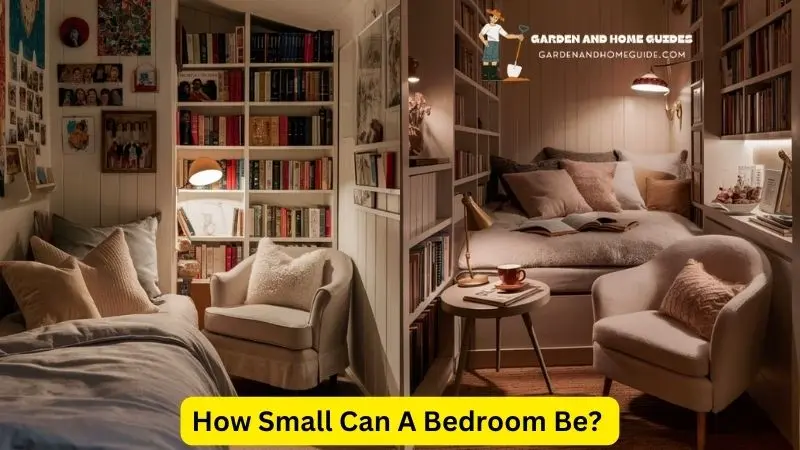Interior
How Small Can A Bedroom Be?
The bedroom, a sanctuary of rest and rejuvenation, is often envisioned as a spacious haven, a place to unwind and escape the stresses of daily life. Yet, in an era of increasingly dense urban environments and rising property prices, the concept of a spacious bedroom is becoming a luxury many can no longer afford. This begs the question: how small can a bedroom be before it ceases to be a comfortable and functional space? The answer, unsurprisingly, is not a simple one.
There is no universally accepted minimum size for a bedroom, and what constitutes a comfortable space varies greatly depending on individual needs and preferences. However, by examining the factors that contribute to a bedroom’s functionality and comfort, we can establish a framework for understanding the minimum dimensions that are generally considered acceptable.
Let’s explore that issue more clearly with Gardenandhomeguide.com in the article below!
How Small Can A Bedroom Be? The Basics of Functionality:
The most fundamental requirement for a bedroom is that it provides enough space for the essential furniture: a bed, a wardrobe, and possibly a bedside table or two. The size of these furniture pieces will vary depending on the individual’s needs and the overall layout of the room. For example, a single bed will require less space than a king-size bed, and a built-in wardrobe can save valuable floor space compared to a freestanding one.
To determine the minimum dimensions for a functional bedroom, we can consider the following guidelines:
- Bed: The bed should be large enough to provide a comfortable sleeping space. A standard single bed measures 90cm x 190cm, while a double bed is 135cm x 190cm. A king-size bed, at 180cm x 200cm, requires significantly more floor space.
- Wardrobe: The wardrobe should be large enough to store all of the occupant’s clothing and belongings. A standard wardrobe can be as small as 60cm wide, while a larger one can be up to 120cm wide.
- Other Furniture: The amount of additional furniture, such as a dressing table, desk, or armchair, will influence the overall space requirement.
Beyond Functionality: Comfort and Aesthetics
While functionality is essential, it is not the sole factor determining a bedroom’s comfort. The overall feeling of the space is equally important. This includes factors such as:
- Ceiling Height: A high ceiling can create a sense of spaciousness, even in a small room. However, a low ceiling can make a room feel cramped and claustrophobic.
- Natural Light: Adequate natural light is crucial for a bedroom’s overall ambience. Windows that allow for sufficient sunlight to enter the room can create a more welcoming and uplifting atmosphere.
- Ventilation: Proper ventilation is essential for maintaining a comfortable temperature and humidity level in the bedroom. This can be achieved through windows, doors, or ventilation systems.
- Storage: Adequate storage space is essential for keeping a bedroom organized and clutter-free. This can be achieved through built-in wardrobes, drawers, shelves, or other storage solutions.
- Personalization: The bedroom should reflect the occupant’s personal style and taste. This can be achieved through the use of colour, artwork, and decorative elements.
The Minimum Dimensions in Practice:
While there is no single answer to the question of how small a bedroom can be, some general guidelines can be applied.
- Single Bedroom: A single bedroom can be as small as 9 square meters, provided that it is well-designed and utilizes space efficiently. This size allows for a single bed, a small wardrobe, and a bedside table.
- Double Bedroom: A double bedroom should ideally be at least 12 square meters to accommodate a double bed, a wardrobe, and some additional furniture.
- Larger Bedrooms: For a more comfortable experience, a larger bedroom is always preferable. A bedroom of 15 square meters or more allows for greater flexibility in furniture arrangement and provides a more spacious feeling.
Beyond Square Footage: The Importance of Design
While square footage is an important factor, it is not the only determinant of a bedroom’s functionality and comfort. The design and layout of the room play a crucial role in maximizing space and creating a welcoming atmosphere.
- Maximizing Vertical Space: Utilizing vertical space through built-in wardrobes, high shelves, and loft beds can create a sense of spaciousness and provide additional storage solutions.
- Strategic Furniture Placement: Placing furniture strategically, such as positioning the bed against a wall to maximize floor space, can create a more open and inviting layout.
- Clever Storage Solutions: Incorporating hidden storage solutions, such as under-bed storage or concealed shelves, can help to minimize clutter and create a more organized and spacious feel.
- Light and Color: Using light and bright colors can make a small bedroom feel larger and more inviting. Natural light should be maximized, and artificial lighting should be used strategically to create a warm and welcoming atmosphere.
The Psychological Impact of Small Bedrooms:
The size of a bedroom can have a significant psychological impact on its occupants. A small bedroom can make a person feel cramped, claustrophobic, and stressed. This can lead to a negative impact on sleep quality, mood, and overall well-being.
However, it is important to note that the psychological impact of a small bedroom is not universal. Some individuals may adapt to a smaller space more easily than others. Factors such as personality, lifestyle, and personal preferences can influence how a person perceives and reacts to a small bedroom.
Conclusion: Finding the Balance
Ultimately, the question of how small a bedroom can be is a subjective one. While there are general guidelines and design principles that can be applied, the most important factor is the individual’s needs and preferences. A bedroom that is too small can be uncomfortable and stressful, but a bedroom that is too large can feel empty and impersonal. The key is to find a balance between functionality, comfort, and aesthetics, creating a space that is both practical and inviting.
In an increasingly urbanized world, where space is at a premium, the challenge of creating comfortable and functional bedrooms in smaller spaces is becoming increasingly relevant. By understanding the factors that contribute to a bedroom’s functionality and comfort, and by applying clever design solutions, it is possible to create a bedroom that is both practical and inviting, regardless of its size.






